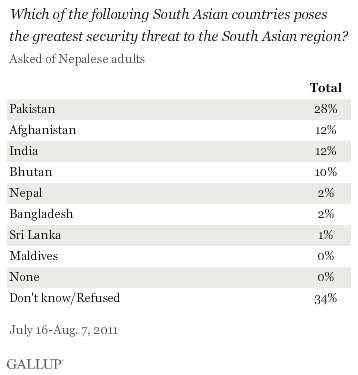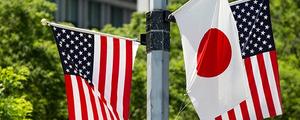BRUSSELS -- Nepalese are roughly twice as likely to identify Pakistan as the greatest threat to South Asian security than Afghanistan or India.

The results, based on a survey that Gallup conducted in mid-July and early August for the South Asia Democratic Forum (SADF), appear to reflect Nepalese respondents' concern about terrorism. Four in 10 Nepalese choose terrorism as the No. 1 security threat to the region. Crime places a distant second, with 20% naming it as the top issue.

Fewer than 1 in 10 (8%) Nepalese say nuclear weapons constitute the greatest security threat and an equal percentage (8%) say the same about rivalry between India and Pakistan. Although Nepal is situated between two rising powers, India and China, their rivalry hardly registers as a security threat.
With concern about terrorism weighing heavily on their minds, Nepalese look with unease at Pakistan -- a country whose own president accuses past governments of having "deliberately created and nurtured" terrorist movements. However, some Nepalese respondents may have been thinking more locally than regionally when answering the question about the greatest security threat. More than five years after Nepal's decade-long civil war ended, local insurgent groups are still fighting for the independence of certain regions in the country.
Implications
Nepal's leaders and others worldwide should take Nepalese worries about Pakistan and terrorism seriously. On the one hand, policymakers need to step up efforts to advance the regional cooperation in South Asia sorely needed to boost regional security. On the other hand, Nepal's leaders must improve security within the country. The recent handover of weapons by former Maoist rebels appears to be a first step in the right direction.
The survey is part of the Insights South Asia project -- a cooperation between SADF and Gallup.
For complete data sets or custom research from the more than 150 countries Gallup continually surveys, please contact SocialandEconomicAnalysis@gallup.com or call 202.715.3030.
Survey Methods
Results are based on face-to-face interviews with 1,000 adults, aged 15 and older, conducted July 16-Aug. 7, 2011, in Nepal. For results based on the total sample of national adults, one can say with 95% confidence that the maximum margin of sampling error is ±3.9 percentage points. The margin of error reflects the influence of data weighting. In addition to sampling error, question wording and practical difficulties in conducting surveys can introduce error or bias into the findings of public opinion polls.
For more complete methodology and specific survey dates, please review Gallup's Country Data Set details.
